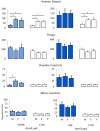Elastic, viscous, and mass load effects on poststroke muscle recruitment and co-contraction during reaching: a pilot study
- PMID: 19443557
- PMCID: PMC2704029
- DOI: 10.2522/ptj.20080128
Elastic, viscous, and mass load effects on poststroke muscle recruitment and co-contraction during reaching: a pilot study
Abstract
Background: Resistive exercise after stroke can improve strength (force-generating capacity) without increasing spasticity (velocity-dependent hypertonicity). However, the effect of resistive load type on muscle activation and co-contraction after stroke is not clear.
Objective: The purpose of this study was to determine the effect of load type (elastic, viscous, or mass) on muscle activation and co-contraction during resisted forward reaching in the paretic and nonparetic arms after stroke.
Design: This investigation was a single-session, mixed repeated-measures pilot study.
Methods: Twenty participants (10 with hemiplegia and 10 without neurologic involvement) reached forward with each arm against equivalent elastic, viscous, and mass loads. Normalized shoulder and elbow electromyography impulses were analyzed to determine agonist muscle recruitment and agonist-antagonist muscle co-contraction.
Results: Muscle activation and co-contraction levels were significantly higher on virtually all outcome measures for the paretic and nonparetic arms of the participants with stroke than for the matched control participants. Only the nonparetic shoulder responded to load type with similar activation levels but variable co-contraction responses relative to those of the control shoulder. Elastic and viscous loads were associated with strong activation; mass and viscous loads were associated with minimal co-contraction.
Limitations: A reasonable, but limited, range of loads was available.
Conclusions: Motor control deficits were evident in both the paretic and the nonparetic arms after stroke when forward reaching was resisted with viscous, elastic, or mass loads. The paretic arm responded with higher muscle activation and co-contraction levels across all load conditions than the matched control arm. Smaller increases in muscle activation and co-contraction levels that varied with load type were observed in the nonparetic arm. On the basis of the response of the nonparetic arm, this study provides preliminary evidence suggesting that viscous loads elicited strong muscle activation with minimal co-contraction. Further intervention studies are needed to determine whether viscous loads are preferable for poststroke resistive exercise programs.
Figures




References
-
- American Heart Association. Heart disease and stroke statistics: 2007 update. Circulation. 2007;115:e69–e171. - PubMed
-
- Harris J, Eng JJ. Paretic upper-limb strength best explains arm activity in people with stroke. Phys Ther. 2007;87:88–97. - PubMed
-
- LeBrasseur NK, Sayers SP, Ouellette MM, Fielding RA. Muscle impairments and behavioral factors mediate functional limitations and disability following stroke. Phys Ther. 2006;86:1342–1350. - PubMed
-
- Wagner JM, Lang CE, Sahrmann SA, et al. Relationships between sensorimotor impairments and reaching deficits in acute hemiparesis. Neurorehabil Neural Repair. 2006;20:406–416. - PubMed
-
- Zackowski KM, Dromerick AW, Sahrmann SA, et al. How do strength, sensation, spasticity, and joint individuation relate to reaching deficits of people with chronic hemiparesis? Brain. 2004;127:1035–1046. - PubMed
Publication types
MeSH terms
Grants and funding
LinkOut - more resources
Full Text Sources
Medical

